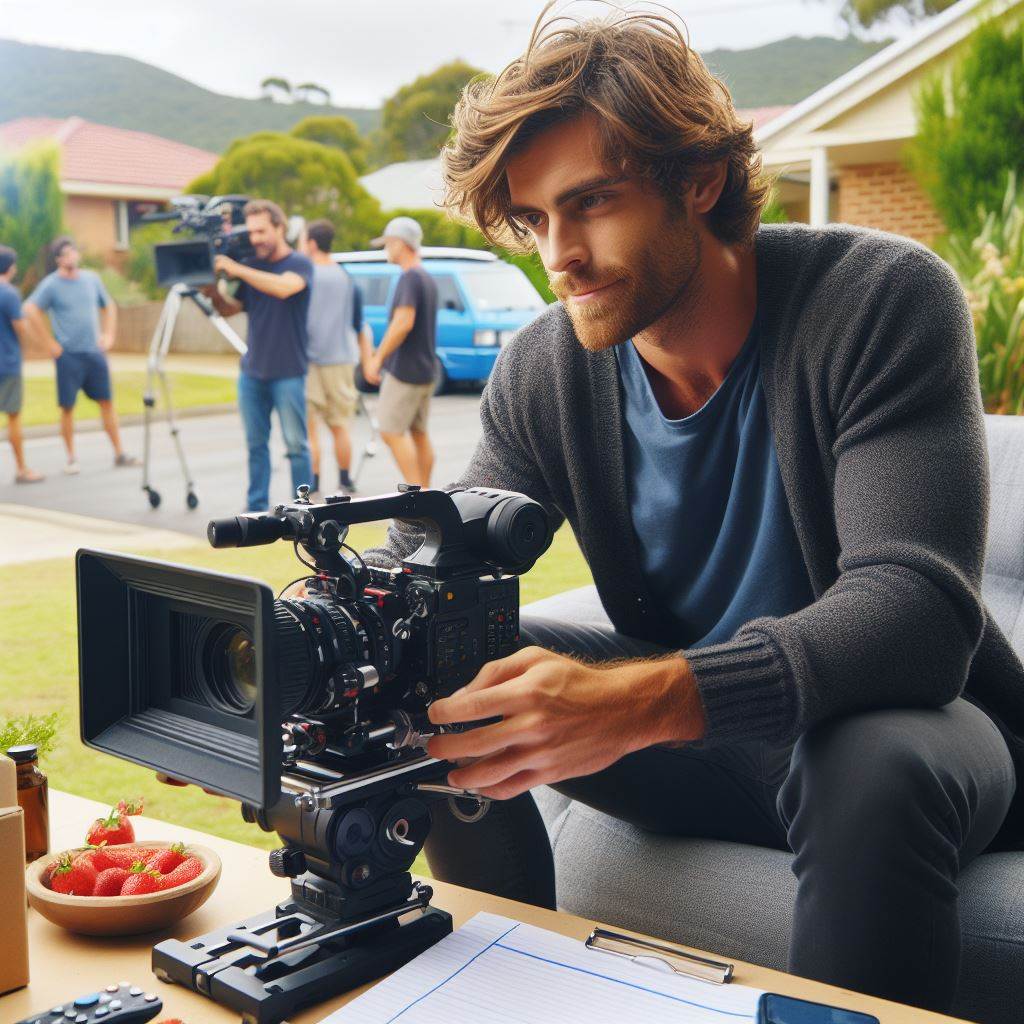Introduction
The landscape of Australian cinema has undergone significant transformations over the years, reflecting a diverse array of stories and styles.
As we venture into the future, the role of directors in shaping the narrative and visual language of Australian films becomes increasingly pivotal.
This discussion delves into the evolving trends, challenges, and innovations that are likely to shape the future of directing in Australian cinema.
Directing stands at the heart of the filmmaking process, serving as the visionary force that brings a script to life.
A director’s decisions regarding cinematography, performance, and overall artistic direction profoundly impact the final product.
They are responsible for translating a written narrative into a visual and emotional experience for the audience.
The director’s ability to navigate the complexities of storytelling, collaborate with a diverse cast and crew, and make creative choices ultimately determines the success of a film.
In the context of Australian cinema, where unique stories and cultural nuances abound, the role of directors becomes even more crucial in capturing and conveying the distinctive essence of the Australian identity on the silver screen.
Historical Perspective
A. The evolution of directing in Australian cinema
The evolution of directing in Australian cinema has seen significant growth. Early directors focused on capturing national identity and landscapes.
The Australian New Wave in the 1970s and 1980s, led by figures like Peter Weir, brought international recognition through innovative filmmaking.
Weir’s films, including “Picnic at Hanging Rock” and “Gallipoli,” uniquely explored the Australian landscape and deep psychological narratives.
George Miller revolutionized action filmmaking with the iconic “Mad Max” series, gaining international attention.
Gillian Armstrong explored feminism in films like “My Brilliant Career,” paving the way for more female directors.
In the 1990s and early 2000s, Baz Luhrmann’s visually captivating films, such as “Strictly Ballroom” and “Australia,” added theatricality to Australian cinema.
Andrew Dominik’s crime drama “Chopper” earned critical acclaim.
The 21st century brought digital technology, with directors like Warwick Thornton using it to explore Indigenous stories.
Recent acclaimed directors, Jennifer Kent (“The Babadook”) and Taika Waititi (“Jojo Rabbit”), continue to push storytelling norms, contributing to Australian cinema’s growth.
On a final note, visionary directors have left an indelible mark on Australian cinema, shaping its future through innovative storytelling and pushing visual boundaries.
B. Notable Australian directors and their contributions
- Peter Weir – Known for capturing the Australian landscape and exploring national identity in films like “Picnic at Hanging Rock” and “Gallipoli.”
- George Miller – Revolutionized action filmmaking with the “Mad Max” series, bringing international attention to Australian cinema.
- Gillian Armstrong – Explored themes of feminism and female empowerment in films like “My Brilliant Career,” paving the way for more female directors.
- Baz Luhrmann – Introduced theatricality and visual extravagance to Australian cinema with films like “Strictly Ballroom” and “Australia.”
- Andrew Dominik – Known for his raw and intense narratives in films like “Chopper,” garnering critical acclaim and international recognition.
- Warwick Thornton – Utilizes digital technology to explore Indigenous stories and break new ground in Australian cinema.
- Jennifer Kent – Directed the critically acclaimed horror film “The Babadook,” challenging traditional storytelling norms.
- Taika Waititi – Pushes the boundaries of storytelling with films like “Jojo Rabbit,” contributing to the growth of Australian directing.
Current State of Directing in Australian Cinema
A. Overview of the current landscape of Australian cinema
- Australian cinema has experienced significant growth and development in recent years.
- The industry has been successful in producing diverse and high-quality films.
- The emergence of new talent and creative storytelling has attracted international recognition.
- Australian cinema has gained a reputation for its unique and authentic storytelling.
B. The role of directors in shaping the industry
- Directors play a crucial role in the filmmaking process, driving the creative vision and execution.
- They are responsible for interpreting the script, casting actors, and overseeing production.
- Directors have a unique perspective that influences the overall aesthetic and narrative of a film.
- They collaborate with various professionals to create a cohesive and engaging cinematic experience.
- Directors have the power to push boundaries, challenge conventions, and bring bold storytelling to life.
C. Recent successes and achievements of Australian directors
- Australian directors have achieved international acclaim with their films receiving critical acclaim and awards.
- George Miller’s “Mad Max: Fury Road” won six Academy Awards, including Best Director.
- Jennifer Kent’s “The Babadook” became a horror cult classic and received widespread recognition.
- Warwick Thornton’s “Samson and Delilah” garnered international attention and won the Cannes Camera d’Or.
- Justin Kurzel’s “Snowtown” was highly praised for its gritty realism and atmospheric storytelling.
- Indigenous filmmakers, such as Ivan Sen and Rachel Perkins, have been celebrated for their unique storytelling and cultural representation.
- Australian directors have successfully tackled various genres, including drama, comedy, and thriller, showcasing their versatility.
In essence, the current state of directing in Australian cinema is thriving.
The industry has witnessed remarkable growth and the emergence of talented directors who have brought unique stories to the global stage.
These directors have shaped the industry through their creative vision and contributions, challenging conventions and pushing boundaries.
Their recent successes and achievements have garnered international recognition, amplifying the reputation of Australian cinema.
With continued support and investment in the industry, Australian directors will continue to shape the future of directing and contribute to the vibrant landscape of Australian cinema.
Read: Australian Music Awards: A Closer Look
Emerging Trends and Challenges
Directing in Australian cinema is undergoing a transformative evolution, propelled by emerging trends and daunting challenges.
A. Emerging Trends in Directing Practices
- Influence of Digital Technology and Visual Effects: Directors in Australia are embracing cutting-edge digital technologies, revolutionizing storytelling through immersive visual effects.
- Increased Collaboration with International Filmmakers: The global landscape beckons, and Australian directors are responding. Collaborations with international filmmakers are expanding horizons, fostering cross-cultural narratives.
B. Challenges Faced by Australian Directors
- Limited Funding Opportunities: Despite a surge in creativity, Australian directors grapple with a persistent challenge—limited funding.
Securing financial support remains a hurdle, hindering ambitious cinematic visions. - Lack of Diversity in Storytelling: Australian cinema faces the imperative of diversification.
The challenge lies in broadening the narrative spectrum, ensuring stories reflect the rich tapestry of the nation. Homogeneity hampers artistic growth.
In navigating these trends and challenges, Australian directors stand at a crossroads, poised for innovation, collaboration, and resilience.
Your Personalized Career Strategy
Unlock your potential with tailored career consulting. Get clear, actionable steps designed for your success. Start now!
Get StartedThe fusion of technology and creativity, along with a concerted effort to address funding gaps and amplify diverse voices, shapes the promising future of directing in Australian cinema.
Read: Music Production: A Guide for Aussies
Discover More: Drone Photography: Rules in Australia
Opportunities for Growth and Development
A. Initiatives and Programs Supporting Australian Directors
Australia has numerous initiatives and programs in place to support and nurture local directing talent.
These include:
- Screen Australia: This government agency provides funding and resources to support Australian filmmakers, including directors.
They offer a range of grants and programs specifically tailored to directors at various stages of their careers. - Film festivals: Australia is well-known for its vibrant film festival scene, which provides a platform for directors to showcase their work and connect with industry professionals.
The Sydney Film Festival and Melbourne International Film Festival are among the most prestigious events. - Industry associations: Organizations like the Australian Directors’ Guild and the Screen Directors Association of Australia play a crucial role in advocating for directors and providing professional development opportunities. They offer workshops, seminars, and networking events.
- Residency programs: Various residency programs, such as the Screen Queensland Talent Development Fund and the Australian Directors’ Guild Residency, offer directors the chance to collaborate with experienced mentors and gain valuable hands-on experience.
B. The Potential for Australia to Become a Directing Hub
Australia has all the ingredients to become a thriving directing hub in the future.
Some factors contributing to this potential include:
- Diverse locations: Australia’s diverse landscapes and urban settings provide filmmakers with unique and versatile filming locations.
This has attracted international productions and created opportunities for local directors to work on high-profile projects. - Technological advancements: The rapid advancement of technology, particularly in the field of digital filmmaking, has democratized the filmmaking process.
Directors can now create high-quality content with lower budgets, further bolstering Australia’s appeal as a directing hub. - Collaborative industry culture: Australian filmmakers have a reputation for their collaborative approach and willingness to support and assist one another.
This collaborative spirit fosters an environment conducive to growth and development for aspiring and established directors alike. - Financial incentives: The Australian government offers attractive financial incentives, such as the Producer Offset and Location Offset, which provide tax rebates and incentives for international productions.
These incentives make Australia an attractive destination for filmmakers, leading to increased opportunities for local directors.
C. Nurturing New Talent and Providing Mentorship
Nurturing new talent and providing mentorship are crucial for the future of directing in Australian cinema.
Here’s why:
- Encouraging diversity: By providing mentorship to emerging directors from diverse backgrounds, the industry can foster a broader range of voices and perspectives in Australian cinema.
- Skills development: Mentorship programs offer emerging directors the opportunity to develop their skills and learn from experienced industry professionals. This guidance can help them navigate the industry and refine their craft.
- Networking opportunities: Mentorship programs often provide networking opportunities for aspiring directors, allowing them to connect with industry insiders and potential collaborators. These connections are invaluable for advancing their careers.
- Continued innovation: Exposure to experienced mentors can inspire young directors to push boundaries and innovate, leading to a richer and more vibrant Australian film industry.
Australia’s film industry offers a supportive environment for directors through various initiatives, programs, and associations.
With its diverse locations, technological advancements, collaborative culture, and financial incentives, Australia has the potential to become a directing hub.
Nurturing new talent and providing mentorship are essential for ensuring the continued growth and development of directing in Australian cinema.
Read: How to Network in Australia’s Music Scene

The Future of Directing in Australian Cinema
A. Direction the industry is heading in terms of directing
- Collaboration between directors and technology experts will play a crucial role in the future.
- Virtual reality and augmented reality could revolutionize the way films are directed and experienced.
- Directors will have a greater focus on creating immersive and interactive storytelling experiences.
- The use of artificial intelligence in directing decisions might become more prevalent.
- Mobile filmmaking and social media platforms will continue to influence the industry.
B. Potential innovations and advancements
- Introduction of advanced motion capture technology will enhance the realism of visual effects.
- Improved camera technologies will allow directors to capture scenes in unique and visually stunning ways.
- AI-driven analytics can help directors analyze audience preferences and make informed creative decisions.
- The use of CGI and visual effects will continue to push the boundaries of storytelling possibilities.
- Increased accessibility to affordable filmmaking equipment will empower aspiring directors.
C. Importance of creativity and diversity in storytelling
- Embracing diverse voices and narratives will lead to richer and more inclusive storytelling.
- Experimenting with unconventional storytelling techniques will challenge the traditional norms of cinema.
- Collaboration with artists from different disciplines will bring fresh perspectives to the filmmaking process.
- Promoting gender equality and diversity in directing roles will pave the way for new and unique stories.
- Encouraging risk-taking and originality will drive innovation and intrigue in Australian cinema.
The future of directing in Australian cinema is heading towards a dynamic and technology-driven landscape.
Stand Out with a Resume That Gets Results
Your career is worth more than a generic template. Let us craft a resume and cover letter that showcase your unique strengths and help you secure that dream job.
Get HiredCollaboration between directors and technology experts will unlock new creative possibilities.
Virtual reality, augmented reality, and AI will transform the way films are directed and experienced.
Innovations in motion capture, camera technologies, and visual effects will enhance the quality of storytelling.
Embracing diversity and promoting creativity in storytelling will lead to a more inclusive and exciting cinematic experience.
Australian directors must embrace these advancements and foster an environment that encourages experimentation and risk-taking.
By doing so, Australian cinema will continue to thrive and captivate audiences worldwide.
Read: The Evolution of Australian Music Genres
Find Out More: Landscape Photography: Capturing Australia
Conclusion
A. Main points discussed in the blog post
Australian cinema’s future hinges on dynamic directing.
Visionary storytellers drive innovation, fostering cultural resonance and global appeal.
Directors spearhead nuanced narratives, amplifying diverse voices crucial for authentic representation.
By championing local talent, the industry can flourish on the international stage.
This transformative role underscores the pivotal role directors play in shaping the identity of Australian cinema.
The significance of directing in Australian cinema’s future
The significance of directing extends beyond artistic expression; it fuels economic growth, attracting global audiences and investors.
Transform Your LinkedIn for Maximum Impact
Elevate your professional brand with a LinkedIn profile that attracts recruiters, showcases your expertise, and maximizes opportunities. Stand out in your industry with a profile built for success.
Boost ProfileAs the cinematic landscape evolves, supporting emerging directors becomes paramount.
Collaboration with diverse creators propels Australian cinema into uncharted territories, fostering a unique cinematic language.
The future lies in empowering directors to push boundaries, embrace technological advancements, and pioneer new storytelling techniques.
C. Call to action for readers to support and celebrate Australian directors
In this call to action, let’s rally behind Australian directors, celebrating their contributions and advocating for increased support.
Whether through film festivals, crowdfunding, or simply amplifying their work, every effort counts.
Together, we can ensure a vibrant future for Australian cinema, where directors continue to shape narratives that resonate on a global scale.




